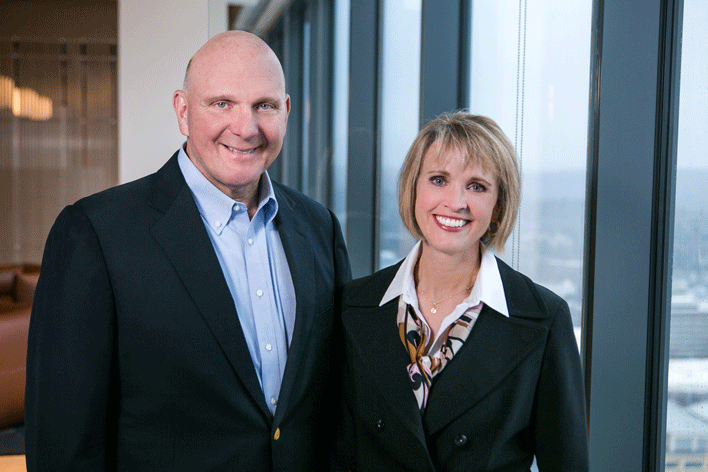Steve Ballmer, who joined Microsoft in its infancy and eventually spent 14 years as CEO, built his career on a technology that has revolutionized modern professional life. But in the world of social services, where his philanthropy is focused, the benefits of that are often nowhere to be seen. In a recent interview with Bloomberg News, Ballmer describes visiting a county department of mental health whose organizational system consisted of “hundreds of sticky notes in a variety of colors tracking things like different types of programs for various ages.”

Steve and Connie Balmer invested $59 million in software to help social services better reach vulnerable kids.
Dysfunction within a single agency is only the beginning. When your mission, like the Ballmer Group’s, is to improve the lives of vulnerable children, almost all conversations eventually converge on the need for “wraparound services.” There are so many different government agencies and nonprofits of all sorts that can help children living below the poverty line, in unstable or even dangerous homes, who may not have enough to eat or who are struggling in school. But whether those different agencies can provide the kind of comprehensive care necessary to help these children depends in part on ensuring that the right hand knows what the left hand is doing. Unfortunately, that is often not the case. There are often multiple public and private organizations trying to help children and families, each one operating separately.
Just as the groups don’t communicate with each other, the technology they use to manage their data couldn’t connect if it tried—“from boxes of forms, to spreadsheets that don’t talk to electronic systems, to very sophisticated custom-built software that doesn’t talk to other software,” explains Korey Klein, a technology specialist at the Ballmer Group. People whose needs might be identified by one part of this system are falling through the cracks because that information is not conveyed to groups that could help. “A great deal of intelligence on how to better serve them is being missed.”
The Ballmers became engaged in this problem several years ago when they gave $9 million for the creation of a data-analytics system to connect Washington state’s local child-welfare agencies and various nonprofits also serving those children. At first it seemed like a success, but as the years went on, it became clear that maintaining its usefulness would require an additional investment of tens of millions of dollars.
So, with an impact investment of $59 million, they partnered with the Austin-based firm Social Solutions—founded by two caseworkers—to develop off-the-shelf software that would allow these nonprofits and government agencies to track their data and better serve their clients. The software would give these organizations a “data dictionary,” a common language that would allow them to share information. And algorithms that Social Solutions is developing would use that data to recommend what other agencies and people should be involved. For instance, after-school programs would be able to not only find out how kids were doing in their classes in real time, they would also be able to suggest, based on students’ profiles, other programs that could benefit them.
Starting in Kansas City and San Antonio, Social Solutions will be providing its software package known as Apricot to more than 40 nonprofits that provide education-related services to underprivileged K-12 students. The hope is to expand to several new cities each year.
Half the Ballmer Group’s investment will go towards a bigger data-science team to accelerate product development. The other half will reduce the price of the software for nonprofits by 50 percent. While Social Solutions is primarily focused on helping education organizations now, the firm’s Alexis Zotalis sees almost limitless possibilities for this kind of data-sharing. Whether it’s organizations that serve the homeless connecting with workforce training or agencies that serve abuse victims working together to help entire families, easing the flow of information and using data analytics to predict what other services could benefit a family would be a great help.
She acknowledges that in some of these areas there may be too much sensitivity to aggregate data. Is there a tech solution for that too? Put the programmers on the case.
